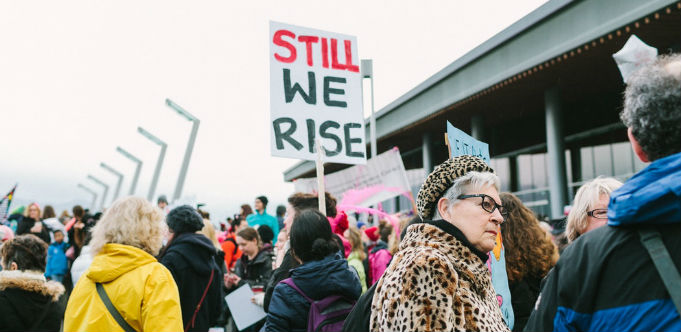
Women’s March in Washington, Vancouver.
Judging by the data the Workplace Gender Equality Agency (WGEA) released last week, we’ve seen solid progress on closing the gender pay gap over the past five years. However, as the report also points out, there’s still much work to be done.
Women’s average full-time base salary across all industries and occupations is 16.2% less than men’s ($15,457 per annum). While women’s’ average full-time total remuneration across all industries and occupations is 21.3% less than men’s ($25,717 per annum).
The three headline takeaways from Australia’s Gender Equality Scorecard 2017-18 were:
- Strong growth in employer action on gender equality over five years;
- Gender pay gap has declined but men earn 21.3% more than women, on average; and
- Steady increase in women in management and leadership roles.
The good news is the gender pay gap has declined every year over the past five, and this year has seen the biggest single-year drop (down 1.1 percentage points) in the average full-time total remuneration gender pay gap. Progress is being made — slowly.
But as the director of the WGEA Libby Lyons identifies in the report, there are significant blind spots when it comes to bridging the gap.
“Last year, our data identified an ‘action gap’. Organisations have policies and strategies in place, but they are not making managers accountable for embedding them in their workplaces. Regrettably, this gap has not narrowed. Although more employers are analysing their pay data, over 40% of those who did took no action,” Lyons said in the report.
“There are a few other problem areas. Access to parental leave has ground to a halt. Although the proportion of women in management has increased, most senior roles, especially at the CEO level, are still dominated by men. Again this year, there is virtually no improvement in the number of women around Australia’s boardroom tables. Just over 35% of the boards and governing bodies in our dataset have no female members.”
It’s widely acknowledged the gender pay gap is a complex issue. It won’t be fixed overnight and it varies from industry to industry, age group to age group, as well as between regions and states. Some of the factors that perpetuate the gender pay gap are systemic discrimination and bias, as well as differences in the earnings potential of employees spread across industries.
But it’s an issue that hurts women, especially over longer periods of time, as men steadily accrue more wealth as a result of greater earnings over the decades. Sadly, single women over the age of 55 are the fastest growing demographic among Australia’s homeless population. Women also leave the workforce when they retire with far less than men in the way of superannuation. The gender pay gap leads to increased financial insecurity and stress for women and their families.
In the same week as the WGEA data was released, the Sydney Women’s Fund released a report that serves as a stark reminder of the financial struggle many women face. Among the report’s survey findings:
- 49% of women said they were “struggling or just getting along”;
- 73% are “concerned about maintaining an adequate income to remain in Sydney”;
- 82% were finding it harder to live in Sydney than a decade ago;
- 61% had experienced discrimination based on race, gender, sexuality or disability in the last year;
- 49% spend 30% or more of their income on housing; and
- 11% are confident they can finance their retirement.
This is a problem we all need to tackle, whether you’re a corporate or smaller business.
Show your support
At the moment, the gender pay gap means women would need to work about 14 months to earn the same on average as men make in a year. In other words, women would need to stack another 62 earning days on the calendar year to achieve annual pay parity with men. To put it bluntly, Australia’s gender pay gap is an embarrassment.
#WalkoutOz wants women and men to walk out of work at 3.50pm on December 5th to support gender pay equity.
Why 3.50pm? Because, in comparison to men, women essentially work an extra 70 or so minutes a day for free. #WalkoutOz wants to demonstrate what that means in a tangible way by walking out of work at the same time women stop getting paid for their work each day.
Fixing the gender pay gap is about fairness, equality and empowerment. Fair and equal pay empowers women, enriches our communities, and ultimately, strengthens our society.
#WalkoutOz event details
- When: 3.50pm – 6.00pm AEDT, Wednesday, December 5, 2018.
- Where: Martin Place Amphitheatre, Sydney CBD.
- Speeches from Australian thought leaders and entertainment from 4pm.
- Don’t work in Sydney? Walk out wherever you are and post a pic to social media with the hashtag #walkoutoz.
- For more information, check out the #WalkoutOz Facebook page.
Disclaimer: Fi Bendall is on the #WalkoutOz organising committee.
NOW READ: Five companies with female founders that are doing amazing things
NOW READ: A “shallow pool”: Women still vastly underrepresented at the executive level


COMMENTS
SmartCompany is committed to hosting lively discussions. Help us keep the conversation useful, interesting and welcoming. We aim to publish comments quickly in the interest of promoting robust conversation, but we’re a small team and we deploy filters to protect against legal risk. Occasionally your comment may be held up while it is being reviewed, but we’re working as fast as we can to keep the conversation rolling.
The SmartCompany comment section is members-only content. Please subscribe to leave a comment.
The SmartCompany comment section is members-only content. Please login to leave a comment.